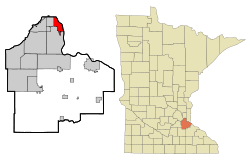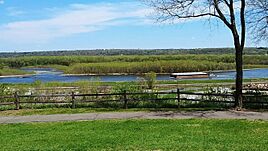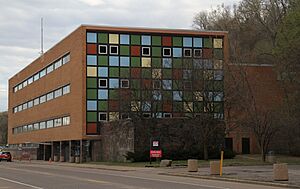South St. Paul, Minnesota facts for kids
Quick facts for kids
South St. Paul
|
|
|---|---|
|
Grandview Park overlooking the Mississippi River
Looking down Grand Avenue in South St. Paul towards the Mississippi River
|
|
| Nickname(s):
S.S.P.
|
|

Location of the city of South St. Paul
within Dakota County, Minnesota |
|
| Country | United States |
| State | Minnesota |
| County | Dakota |
| Incorporated | March 2, 1887 |
| Government | |
| • Type | Mayor (Municipal) |
| Area | |
| • Total | 6.07 sq mi (15.73 km2) |
| • Land | 5.63 sq mi (14.57 km2) |
| • Water | 0.45 sq mi (1.16 km2) |
| Elevation | 719 ft (219 m) |
| Population
(2020)
|
|
| • Total | 20,759 |
| • Estimate
(2022)
|
20,506 |
| • Density | 3,690.49/sq mi (1,424.98/km2) |
| Time zone | UTC−6 (Central (CST)) |
| • Summer (DST) | UTC−5 (CDT) |
| ZIP Codes |
55075, 55076
|
| Area code(s) | 651 |
| FIPS code | 27-61492 |
| GNIS feature ID | 0652339 |
South St. Paul is a city in Dakota County, Minnesota, United States. It is located just south and southeast of the larger city of St. Paul. In 2020, about 20,759 people lived there.
South St. Paul was once a very important place for meat-packing. Many people who live there today are descendants of immigrants from Southern and Eastern Europe. These families came to the city in the early 1900s to work in the meat-packing plants. The city got its name because it is located south of St. Paul. A post office has been open in South St. Paul since 1888.
Contents
Where is South St. Paul Located?
South St. Paul covers an area of about 6 square miles (15.7 square kilometers). Most of this area is land, with a small part being water.
How to Get Around South St. Paul
Several major roads pass through the city. These include Interstate Highway 494, U.S. Highway 52, and Dakota County Road 56. The city also has a small airport called Fleming Field. This airport is used for general aviation, which means it's for private planes, not large passenger jets.
South St. Paul's History with Meat-Packing
Historically, the main industry in South St. Paul was the Saint Paul Union Stockyards. Stockyards are places where livestock (like cattle and pigs) are gathered before being sent to meat-packing plants. The two biggest companies and employers in the city during this time were Swift's & Company and Armour Meats. These companies processed a lot of meat.
The stockyards closed in 2008. Now, much of that area is being redeveloped. This means new buildings and businesses are being built there.
Who Lives in South St. Paul?
| Historical population | |||
|---|---|---|---|
| Census | Pop. | %± | |
| 1860 | 907 | — | |
| 1870 | 1,103 | 21.6% | |
| 1880 | 489 | −55.7% | |
| 1890 | 2,242 | 358.5% | |
| 1900 | 2,322 | 3.6% | |
| 1910 | 4,510 | 94.2% | |
| 1920 | 6,860 | 52.1% | |
| 1930 | 10,009 | 45.9% | |
| 1940 | 11,844 | 18.3% | |
| 1950 | 15,909 | 34.3% | |
| 1960 | 22,032 | 38.5% | |
| 1970 | 25,016 | 13.5% | |
| 1980 | 21,235 | −15.1% | |
| 1990 | 20,197 | −4.9% | |
| 2000 | 20,167 | −0.1% | |
| 2010 | 20,160 | 0.0% | |
| 2020 | 20,759 | 3.0% | |
| 2022 (est.) | 20,506 | 1.7% | |
| U.S. Decennial Census 2020 Census |
|||
We can learn about the people living in South St. Paul by looking at census data. A census is an official count of a population.
Population in 2020
In 2020, the city had 20,759 residents.
- About 81% of the people were White.
- About 3.2% were African American.
- About 0.8% were Native American.
- About 2% were Asian.
- About 6.2% were from two or more racial backgrounds.
- People of Hispanic or Latino heritage made up about 14.2% of the population.
About 24.3% of the residents were under 18 years old. About 13% were 65 years old or older. The population was almost evenly split between genders, with 50.9% being female.
Population in 2010
In 2010, there were 20,160 people living in South St. Paul. There were 8,186 households, which are groups of people living together in one home. About 5,065 of these were families.
- About 85.3% of residents were White.
- About 3.9% were African American.
- About 0.8% were Native American.
- About 1.2% were Asian.
- About 5.4% were from other racial backgrounds.
- About 3.4% were from two or more racial backgrounds.
- People of Hispanic or Latino heritage made up about 12.2% of the population.
About 31.4% of households had children under 18 living with them. Many households were married couples, while others were led by a single parent. About 30.1% of all households were made up of people living alone. The average age in the city was 36.9 years old.
Famous People from South St. Paul
Many notable people have connections to South St. Paul. Here are a few:
- Jim Carter, a football player.
- Justin Faulk, a hockey player.
- Trevor Fehrman, an actor and writer.
- Rollin Glewwe, a politician who served in the Minnesota state senate.
- Grant Hart, a drummer.
- Phil Housley, a hockey player.
- Sunisa Lee, an Olympic gold medalist in gymnastics.
- Harold LeVander, a former Governor of Minnesota.
- Betty McCollum, who serves in the U.S. Congress.
- Tim Pawlenty, another former Governor of Minnesota.
- James Patrick Shannon, a former Roman Catholic Bishop.
- Alex Stalock, a professional hockey goaltender.
- Kathy Tingelstad, a Minnesota State Representative.
- Conrado Vega, a Minnesota state senator.
- Doug Woog, a hockey player.
- Marguerite Cole, known as the first woman to vote in the United States.
See also
 In Spanish: South St. Paul (Minnesota) para niños
In Spanish: South St. Paul (Minnesota) para niños




